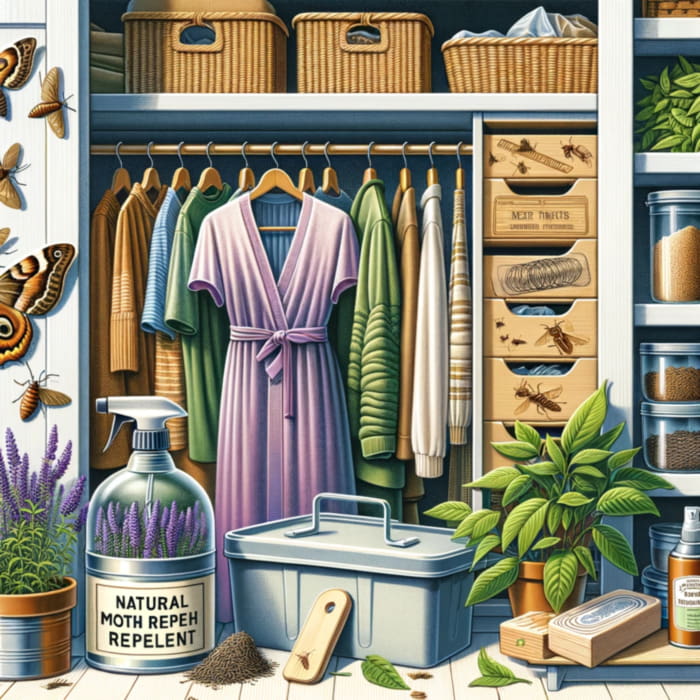Moths in your home, particularly in closets and wardrobes, can be a persistent and frustrating problem. This article is a comprehensive guide on how to effectively rid your home of moths, prevent future infestations, and protect your belongings from these unwanted pests. We’ll explore the signs of moth infestation, identify different types of moths, and provide practical, easy-to-implement solutions to get rid of moths and keep them away for good. Whether you’re dealing with a current infestation or want to take preventative measures, this article is a must-read.
Understanding Moth Infestations: What Attracts Moths to Your Home?
Moth infestations are largely influenced by attractive conditions for survival and proliferation inside homes. Items offering nourishment like wool, furs, or stored food may attract moths, which feed on these substances. Additionally, moths are attracted to dark, undisturbed areas that mimic their natural environment like cupboards, closets, or basements where they can reproduce in peace. Moreover, overripe fruits can also attract moths due to their fermenting smell that mimics the scent of nectar. Therefore, cleanliness, regular inspection, and proper storage of food and clothing can deter moths from infesting homes, saving your belongings from potential damage.
Identifying the Enemy: Different Types of Moths in Your Home
Identifying the enemy that might be invading your home is the first step in countering its potential damage. If the invader is a moth, then it’s important to understand that there are different types. Some such as pantry moths target food in your cupboards, while others like clothes moths pose a threat to your wardrobes. Other species such as carpet and case-bearing moths attack fabrics and upholsteries. Each requires a different approach for control and elimination. Therefore, correctly identifying the species of moth in your home is crucial for effective pest management.
Early Warning Signs: How to Detect a Moth Infestation
Detecting a moth infestation early on can prevent substantial damage to your home and belongings. Telltale signs include small holes in fabrics or carpets, discoloured patches on clothing, a musty smell, and an unusually high amount of moths flying around. Additionally, moth larvae or silken tubes, and cocoons in corners or on walls, may indicate an infestation. Webbing or clumps in cereal, grains, or dried goods are also warning signs. Regular inspection of these areas, followed by immediate action at the first sign of trouble, can save you from a frustrating, costly clean-up.
The Battle Begins: Effective Ways to Get Rid of Moths
The battle against moths begins by adopting preventive and proactive methods. Effective ways of getting rid of these pests include thorough cleaning of your clothes and cupboards, using mothballs or repellents, and moth-proofing your storage areas. Traps are also helpful in eliminating moths. For significant infestations, professional pest control services are recommended to ensure complete eradication and to prevent future infestations.
How to get rid of moths naturally
Natural solutions such as cedar and essential oils are becoming increasingly popular in combatting common household pests like moths. The aroma produced by cedar wood and certain essential oils, such as lavender, repel moths without the need for harsh chemicals. Lining clothing drawers with cedar or spritzing favourite garments with diluted essential oils can offer a gentle, eco-friendly way to protect your fabrics from destructive moth larvae.
Chemical Warfare: When to Use Pest Control Services
Chemical warfare against pests is sometimes necessary to maintain a healthy and safe environment. While minor infestations can often be handled using store-bought products, when the situation escalates and becomes unmanageable, it’s recommended to call in pest control services. Professionals have access to stronger and more effective treatments, and they have the expertise to apply them safely and efficiently. Moreover, they can identify the source of the infestation and provide strategies for preventing future issues. Hence, using pest control services can be a reliable and efficient approach in severe pest situations.
Preventive Measures: How to Keep Moths from Returning
To prevent moths from returning, start by cleaning and sealing off the affected areas. Maintain cleanliness and vacuum frequently to eliminate any remaining moth eggs or larvae. Lavender sachets or cedar balls can be used as natural repellance, as well as pheromone traps to intercept male moths. Regularly inspect your stored food and clothes to catch any early signs of infestation. Keep food and garments in insect-proof containers. Sealing your garments inside freezer bags and freezing them for a few days can kill any existing moth eggs or larvae.
Caring for Your Clothes: Best Practices to Ward Off Moths
Proper care for your clothes is essential to keep them safe and in good condition. One common problem in clothes maintenance is moth infestation, which can eat away and ruin fabrics. To ward off moths, maintain clean storage spaces and make sure clothing items, especially those made from natural fibres like wool and silk, are clean before storing. Using natural repellents such as cedar wood or lavender sachets can deter moths. Additionally, maintaining a dry, well-ventilated area can also help prevent moths as they typically thrive in damp conditions.
Moth-Proofing Your Pantry: Protecting Your Food from Moths
Moth-proofing your pantry is a crucial step in protecting your food from potential infestation. Moths, particularly pantry moths, are known to lay their eggs in grains, flour, cereals, and a variety of stored food items, leading to contamination. To prevent this occurrence, always store food in air-tight, sealed containers, regularly clean pantry shelves and check for larvae or moth signs in food packages before purchasing. Maintaining cleanliness, regularly inspecting food stocks and promptly clearing out infested food can significantly help in protecting your food from moths.
How to get rid of moths outside
Getting rid of moths outside can be accomplished by several methods. Firstly, consider hanging moth traps that are odour free and non-toxic to other animals. These traps use pheromones to attract and catch the moths. Secondly, opt for specialized moth-repellent lighting, as regular outdoor lights tend to attract them. You could also introduce natural predators, like birds and bats, into your backyard by installing birdhouses or bat boxes. Above all, maintain a clean outdoor area by disposing of rotting fruits and limiting sources of outdoor lighting especially at night.
What is the best prevention for moths?
Regular cleaning and maintenance of clothes and pantry are the best preventative measure against moths. This includes vacuuming, washing, dry cleaning, and properly storing clothes and food. Also, the use of mothballs, cedar blocks, traps, or spray, ensures an extra layer of protection to keep your home moth-free.
Long-Term Strategies: What is the best treatment to kill moths?
Long-term strategies for maintaining a moth-free home include proper storage and treatment of moth-prone items. Regularly clean and vacuum to remove larvae, seal cracks in walls and furniture, and regularly seal items in airtight containers. Use mothballs, cedar chips, or lavender sachets in storage and closets to repel moths. Regular inspections will ensure early detection and prevention of infestations.
Conclusion: Key Takeaways
- Understand what attracts moths to your home and learn to identify different types.
- Detect signs of moth infestation early.
- Implement effective strategies to get rid of moths, using both natural and chemical methods.
- Follow preventive measures to keep moths from returning.
- Regularly clean and maintain your home to ensure it remains moth-free, and consider Home Plumbing Maintenance for overall household upkeep.


